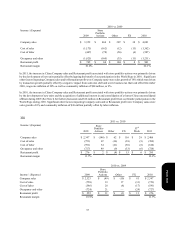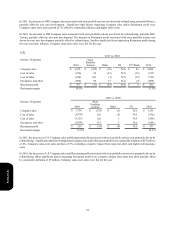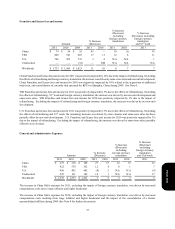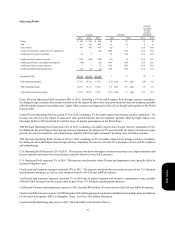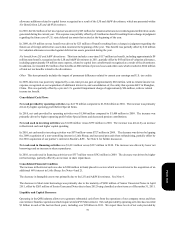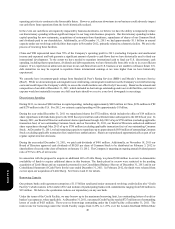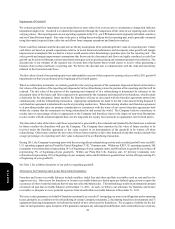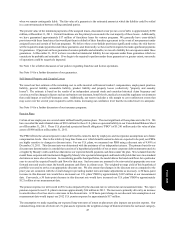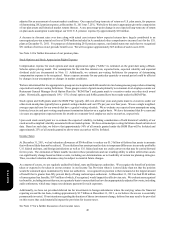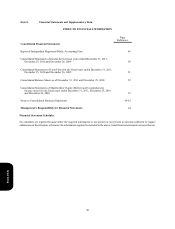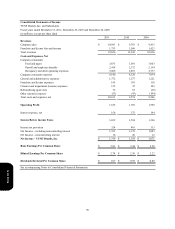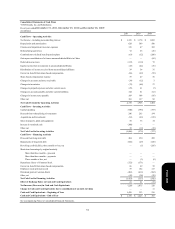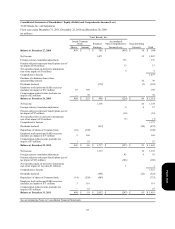Pizza Hut 2011 Annual Report Download - page 147
Download and view the complete annual report
Please find page 147 of the 2011 Pizza Hut annual report below. You can navigate through the pages in the report by either clicking on the pages listed below, or by using the keyword search tool below to find specific information within the annual report.
43
prospectively. The Company is currently evaluating the impact of adopting ASU 2011-04, but currently believes there will be no
significant impact on its consolidated financial statements.
In June 2011, the FASB issued Accounting Standards Update No. 2011-05, Comprehensive Income (Topic 220)-Presentation of
Comprehensive Income (ASU 2011-05), to require an entity to present the total of comprehensive income, the components of net
income, and the components of other comprehensive income either in a single continuous statement of comprehensive income or
in two separate but consecutive statements. ASU 2011-05 eliminates the option to present the components of other comprehensive
income as part of the statement of equity. ASU 2011-05 is effective for the Company in its first quarter of fiscal 2012 and will be
applied retrospectively. The Company currently believes there will be no significant impact on its consolidated financial statements
as a result of adopting this standard.
Critical Accounting Policies and Estimates
Our reported results are impacted by the application of certain accounting policies that require us to make subjective or complex
judgments. These judgments involve estimations of the effect of matters that are inherently uncertain and may significantly impact
our quarterly or annual results of operations or financial condition. Changes in the estimates and judgments could significantly
affect our results of operations, financial condition and cash flows in future years. A description of what we consider to be our
most significant critical accounting policies follows.
Impairment or Disposal of Long-Lived Assets
We review long-lived assets of restaurants (primarily PP&E and allocated intangible assets subject to amortization) that are currently
operating semi-annually for impairment, or whenever events or changes in circumstances indicate that the carrying amount of a
restaurant may not be recoverable. We evaluate recoverability based on the restaurant’s forecasted undiscounted cash flows, which
incorporate our best estimate of sales growth and margin improvement based upon our plans for the unit and actual results at
comparable restaurants. For restaurant assets that are deemed to not be recoverable, we write down the impaired restaurant to its
estimated fair value. Key assumptions in the determination of fair value are the future after-tax cash flows of the restaurant, which
are reduced by future royalties a franchisee would pay, and discount rate. The after-tax cash flows incorporate reasonable sales
growth and margin improvement assumptions that would be used by a franchisee in the determination of a purchase price for the
restaurant. Estimates of future cash flows are highly subjective judgments and can be significantly impacted by changes in the
business or economic conditions.
We perform an impairment evaluation at a restaurant group level if it is more likely than not that we will refranchise restaurants
as a group. Expected net sales proceeds are generally based on actual bids from the buyer, if available, or anticipated bids given
the discounted projected after-tax cash flows, reduced by future royalties a franchisee would pay, for the group of restaurants. The
after-tax cash flows used in determining the anticipated bids incorporate reasonable assumptions we believe a franchisee would
make such as sales growth and margin improvement as well as expectations as to the useful lives of the restaurant
assets. Historically, these anticipated bids have been reasonably accurate estimations of the proceeds ultimately received.
The discount rate used in the fair value calculations is our estimate of the required rate of return that a franchisee would expect
to receive when purchasing a similar restaurant or groups of restaurants and the related long-lived assets. The discount rate
incorporates rates of returns for historical refranchising market transactions and is commensurate with the risks and uncertainty
inherent in the forecasted cash flows.
We have certain definite-lived intangible assets that are not attributable to a specific restaurant, such as trademark/brand intangible
assets and franchise contract rights, which are amortized over their expected useful lives. We base the expected useful lives of
our trademark/brand intangible assets on a number of factors including the competitive environment, our future development plans
for the applicable Concept and the level of franchisee commitment to the Concept. We generally base the expected useful lives
of our franchise contract rights on their respective contractual terms including renewals when appropriate.
These definite-lived intangible assets are evaluated for impairment whenever events or changes in circumstances indicate that the
carrying amount of the intangible asset may not be recoverable. An intangible asset that is deemed impaired is written down to
its estimated fair value, which is based on discounted after-tax cash flows. For purposes of our impairment analysis, we update
the cash flows that were initially used to value the definite-lived intangible asset to reflect our current estimates and assumptions
over the asset’s future remaining life.
See Note 2 for a further discussion of our policy regarding the impairment or disposal of property, plant and equipment.
Form 10-K


